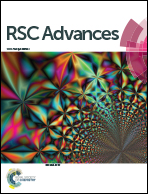One-step synthesis of the nickel foam supported network-like ZnO nanoarchitectures assembled with ultrathin mesoporous nanosheets with improved lithium storage performance†
Abstract
A novel network-like ZnO nanoarchitecture supported on nickel foam (ZnO@NF) is synthesized successfully via a facile one-step hydrothermal route. The obtained ZnO nanoarchitectures firmly grow on the skeleton of nickel foam, exhibiting network-like porous structures assembled with massive interconnected ultrathin mesoporous ZnO nanosheets. When evaluated directly as binder-free anode for lithium-ion batteries, the resultant ZnO@NF electrodes exhibit excellent lithium storage performance with a high reversible capacity (760.5 mA h g−1 at a current density of 200 mA g−1), improved cycling performance (the capacity maintains at 534.3 mA h g−1 after 100 cycles), and better rate capability compared with binder-containing counterparts. The improved electrochemical performances could be attributed to the unique network-like mesoporous microstructure and the integrated smart architecture, which could facilitate the electron transport and lithium ion diffusion, and buffer the volume change during repeated charge/discharge process effectively.


 Please wait while we load your content...
Please wait while we load your content...